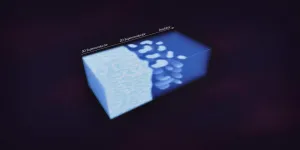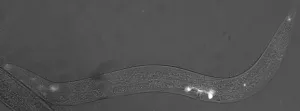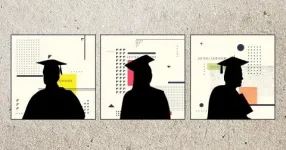(Press-News.org) Creating a two-dimensional material, just a few atoms thick, is often an arduous process requiring sophisticated equipment. So scientists were surprised to see 2D puddles emerge inside a three-dimensional superconductor - a material that allows electrons to travel with 100% efficiency and zero resistance - with no prompting.
Within those puddles, superconducting electrons acted as if they were confined inside an incredibly thin, sheet-like plane, a situation that requires them to somehow cross over to another dimension, where different rules of quantum physics apply.
"This is a tantalizing example of emergent behavior, which is often difficult or impossible to replicate by trying to engineer it from scratch," said Hari Manoharan, a professor at Stanford University and investigator with the Stanford Institute for Materials and Energy Sciences (SIMES) at the Department of Energy's SLAC National Accelerator Laboratory, who led the research.
"It's as if when given the power to superconduct," he said, "the 3D electrons choose for themselves to live in a 2D world."
The research team calls this new phenomenon "inter-dimensional superconductivity," and in a report in the Proceedings of the National Academy of Sciences today, they suggest that this is how 3D superconductors reorganize themselves just before undergoing an abrupt shift into an insulating state, where electrons are confined to their home atoms and can't move around at all.
"What we found was a system where electrons behave in unexpected ways. That's the beauty of physics," said Carolina Parra, a postdoctoral researcher at SLAC and Stanford at the time of the study who carried out the experiments that led to the visualization of this intriguing result. "We were very lucky to find this behavior."
Electrons acting strangely
Although superconductivity was discovered more than a century ago, its usefulness was limited by the fact that materials became superconducting only at temperatures close to those of deep space.
So the announcement in 1986 that scientists had discovered a new and unexpected class of superconducting materials that operated at much higher - although still very cold - temperatures set off a tsunami of research that continues to this day, with the goal of figuring out how the new materials operate and developing versions that work at closer to room temperature for applications such as perfectly efficient power lines and maglev trains.
This study started with a high-temperature superconductor named BPBO for its four atomic ingredients - barium, lead, bismuth and oxygen. It was synthesized in the lab of Stanford Professor and SIMES investigator Ian Fisher by Paula Giraldo-Gallo, a PhD student at the time.
As researchers there put it through routine tests, including determining the transition temperature at which it flips between a superconducting and an insulating phase - like water changing to steam or ice - they realized that their data showed electrons behaving as if they were confined to ultrathin, 2D layers or stripes within the material. This was a puzzle, because BPBO is a 3D superconductor whose electrons are normally free to move in any direction they like.
Intrigued, Manoharan's team took a closer look with a scanning tunneling microscope, or STM - an instrument that can identify and even move individual atoms in the top few atomic layers of a material.
Interacting puddles
The stripes, they discovered, seemed to have no relationship with the way the material's atoms were organized or with tiny bumps and dips on its surface.
"Instead, the stripes were layers where electrons behave as if they are confined to 2D, puddle-like areas in the material," Parra said. "The distance between puddles is short enough that the electrons can 'see' and interact with each other in a way that allows them to move without resistance, which is the hallmark of superconductivity."
The 2D puddles emerged as the scientists carefully adjusted the temperature and other conditions toward the transition point where the superconductor would become an insulator.
Their observations closely match a theory of "emergent electronic granularity" in superconductors, developed by Nandini Trivedi of Ohio State University and colleagues.
"The predictions we had made went against the standard paradigm for superconductors," Trivedi said. "Usually, the stronger a superconductor is, the more the energy needed to break the bond between its superconducting electron pairs - a factor we call the energy gap. But my group had predicted that in this particular type of disordered superconductor, the opposite would be true: The system would form emergent puddles where superconductivity was strong but the pairs could be broken with much less energy than expected.
"It was quite thrilling to see those predictions being confirmed by the STM measurements from the Stanford group!"
Spreading the science
The results have practical implications for crafting 2D materials, Parra said.
"Most of the methods for making 2D materials are engineering approaches, like growing films a few atomic layers thick or creating a sharp interface between two materials and confining a 2D state there," she said. "This offers an additional way to get to these 2D superconducting states. It's cheaper, you don't need fancy equipment that requires very low temperatures and it doesn't take days and weeks. The only tricky part would be getting the composition of the material just right."
Parra now heads a lab at the Federico Santa Mari?a Technical University in Valparai?so, Chile, focusing on interdisciplinary studies of nanoscale biological materials. She recently won a grant to acquire and operate the first-ever low-temperature scanning tunneling microscope in South America, which she plans to use to continue this line of research.
"When I have this equipment in the lab," she said, "I will connect it with all the things I learned in Hari's lab and use it to teach a new generation of researchers that we're going to have working in nanoscience and nanotechnology in Chile."
INFORMATION:
The research was funded by the DOE Office of Science.
Citation: Carolina Parra et al., Proceedings of the National Academy of Sciences, 12 April 2021 (10.1073/pnas.201781011)
SLAC is a vibrant multiprogram laboratory that explores how the universe works at the biggest, smallest and fastest scales and invents powerful tools used by scientists around the globe. With research spanning particle physics, astrophysics and cosmology, materials, chemistry, bio- and energy sciences and scientific computing, we help solve real-world problems and advance the interests of the nation.
SLAC is operated by Stanford University for the U.S. Department of Energy's Office of Science. The Office of Science is the single largest supporter of basic research in the physical sciences in the United States and is working to address some of the most pressing challenges of our time.
When Iranian authorities started seizing Barbie dolls from Tehran toy shops in 2012, Mattel Inc. execs faced concerns not only about the dolls' attire -- miniskirts and swimsuits considered immodest in an Islamic country -- but also questions from the U.S. Securities and Exchange Commission (SEC) about Mattel's ties to Iran.
U.S. businesses are restricted from business in Iran, which U.S. authorities have designated a state sponsor of terrorism (SST). The number of SEC inquiries about potential terrorist ties has grown substantially in recent years, and according to new research from Duke University's Fuqua School of Business, the increase could reduce the quality of the agency's financial reporting oversight.
"Comments on terrorism are getting to a critical level of importance ...
Really big systems, like ocean currents and weather, work on really big scales. And so too does your plastic waste, according to new research from Janice Brahney from the Department of Watershed Sciences. The plastic straw you discarded in 1980 hasn't disappeared; it has fragmented into pieces too small to see, and is cycling through the atmosphere, infiltrating soil, ocean waters and air. Microplastics are so pervasive that they now affect how plants grow, waft through the air we breathe, and permeate distant ecosystems. They can be found in places as varied as the human bloodstream to ...
To maximise absorption of nutrients from the diet, the intestinal mucous membrane has a large surface area. However, this also makes it vulnerable to attack from aggressive gut microbes. A new study by Uppsala University researchers now shows that the surface layer of the mucosa, known as the epithelium, can rapidly contract when it recognises a bacterial attack. The results are published in the journal PNAS.
Every year, hundreds of millions of people worldwide suffer from bacterial gut infections of one kind or another, which are often hard to treat. Antibiotics can kill the normal flora of the intestine, ...
Researchers at the University of British Columbia have discovered three liquid phases in aerosol particles, changing our understanding of air pollutants in the Earth's atmosphere.
While aerosol particles were known to contain up to two liquid phases, the discovery of an additional liquid phase may be important to providing more accurate atmospheric models and climate predictions. The study was published today in PNAS.
"We've shown that certain types of aerosol particles in the atmosphere, including ones that are likely abundant in cities, can often have three distinct liquid phases." says ...
Using laboratory-grown roundworms as well as human and mouse eye tissue, University of Maryland School of Medicine (UMSOM) researchers have identified a new potential mechanism for age-related macular degeneration--the leading cause of blindness among older adults. The UMSOM researchers say that the findings suggest a new and distinct cause that is different from the previous model of a problematic immune system, showing that the structural organization of the eye's light-detecting cells may be affected by the disease.
The discovery offers the potential to identify new molecular targets to treat the disease. Their discovery was published on April 12 in the Proceedings of the National Academy of Sciences (PNAS).
According to the National Eye Institute, ...
PRINCETON, N.J.--Increasing diversity remains a key priority at universities, especially in the wake of mass demonstrations in support of racial equality in 2020 following the death of George Floyd. Many universities are guided by the motivation that diversity enhances student learning, a rationale supported by the U.S. Supreme Court.
This approach, however, is a view preferred by white and not Black Americans, and it also aligns with better relative outcomes for white Americans, according to a paper published by Princeton University researchers in the Proceedings of the National Academy of Sciences.
Across eight studies including 1,200 participants, the researchers looked at two different approaches to diversity: an "instrumental rationale," which asserts that including ...
BOSTON - Many patients with cancer receive immune checkpoint inhibitors that strengthen their immune response against tumor cells. While the medications can be life-saving, they can also cause potentially life-threatening side effects in internal organs. This double-edged sword makes it challenging for clinicians to decide who should be considered candidates for treatment. A new analysis led by researchers at Massachusetts General Hospital (MGH) indicates which patients are at elevated risk of side effects severe enough to require hospitalization. The findings are published in the END ...
BOSTON - Immune checkpoint inhibitors, which boost the immune system's response against tumor cells, have transformed treatment for many advanced cancers, but short-term clinical trials and small observational studies have linked the medications with various side effects, most commonly involving the skin. A more comprehensive, population-level analysis now provides a thorough look at the extent of these side effects and provides insights on which patients may be more likely to experience them. The research was led by investigators at Massachusetts General ...
Abstract #LB008
HOUSTON -- A preclinical study led by researchers at The University of Texas MD Anderson Cancer Center shows an antibody-drug conjugate (ADC) targeting surface protein MT1-MMP can act as a guided missile in eradicating osteosarcoma tumor cells without damaging normal tissues. This technology, using precision therapy targeting of cell-surface proteins through a Bicycle toxin conjugate (BTC), shows encouraging results for the treatment of osteosarcoma.
Findings from the study were presented today by Yifei Wang, M.D., a postdoctoral fellow of Pediatrics Research, at the virtual ...
Blood taken from a small group of children before the COVID-19 pandemic contains memory B cells that bind SARS-CoV-2 and weakly cross-react with other coronaviruses, a new study finds, while adult blood and tissue showed few such cells. "Further study of the role of cross-reactive memory B cell populations... will be important for ongoing improvement of vaccines to SARS-CoV-2, its viral variants, and other pathogens," the authors say. As the COVID-19 pandemic has continued, children have often exhibited faster viral clearance and lower viral antigen loads than adults; whether B cell repertoires against SARS-CoV-2 (and other pathogens) differ between children and ...




